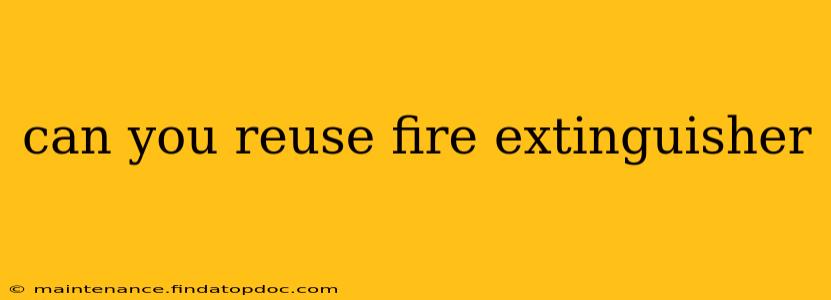Fire extinguishers are vital safety tools, but their effectiveness depends heavily on proper maintenance and responsible use. A common question that arises after using a fire extinguisher is: can you reuse it? The short answer is: sometimes, but it's complicated and rarely advisable for the average person. Let's delve into the specifics.
What Happens When a Fire Extinguisher is Used?
When you discharge a fire extinguisher, you deplete its pressurized extinguishing agent. This agent, whether it's water, foam, dry chemical, or CO2, is expelled under pressure to quell flames. Beyond the agent's depletion, using the extinguisher also introduces potential contaminants into the system. These contaminants can include debris from the fire, smoke residue, and potentially corrosive byproducts.
Can I Recharge a Fire Extinguisher Myself?
No. While some fire extinguishers might appear straightforward, recharging them is far more complex than simply refilling the tank. It requires specialized tools, training, and knowledge of pressure gauges, safety procedures, and the specific type of extinguisher. Improperly recharging an extinguisher can lead to:
- Malfunction: The extinguisher might fail to discharge when needed, potentially putting lives and property at risk.
- Explosion: Incorrect pressure levels can cause a catastrophic explosion.
- Inaccuracy: An improperly recharged extinguisher might not distribute the extinguishing agent effectively.
Attempting to recharge a fire extinguisher without the necessary expertise is extremely dangerous and strongly discouraged.
How Can I Get a Used Fire Extinguisher Recharged?
The safest and most reliable approach is to contact a certified fire extinguisher service provider. These professionals possess the expertise, equipment, and licensing to properly inspect, test, recharge, and maintain your fire extinguishers. They will:
- Inspect the extinguisher: Thoroughly assess its condition for damage or contamination.
- Hydrostatically test (if necessary): This crucial test checks the integrity of the cylinder to ensure it can withstand pressure.
- Recharge the extinguisher: Safely refill the extinguisher with the correct extinguishing agent and to the correct pressure.
- Tag and label: Apply appropriate tags and labels indicating the recharge date and any necessary certifications.
What if My Fire Extinguisher is Damaged?
If your extinguisher shows signs of damage—dents, cracks, corrosion, or significant wear—it should be replaced, not recharged. A damaged extinguisher is a safety hazard and cannot be reliably restored to operational status.
How Often Should I Have My Fire Extinguisher Serviced?
Regular servicing is crucial for fire extinguisher effectiveness. The frequency varies depending on local regulations and the type of extinguisher, but a yearly inspection and service are commonly recommended. Your local fire marshal or a fire extinguisher service provider can provide the most accurate recommendations for your specific situation.
Is it Cheaper to Recharge or Replace a Fire Extinguisher?
While recharging is typically less expensive than replacement, the cost savings are negligible when weighed against the potential risks of improper handling. The peace of mind and safety provided by a professionally serviced or replaced extinguisher far outweigh the minor price difference.
What are the Different Types of Fire Extinguishers?
Understanding the different classes of fire extinguishers (A, B, C, D, K) is vital for selecting the appropriate equipment for your needs. This information is crucial for ensuring you're using the right extinguisher for the specific type of fire. Each type uses different agents suited to particular flammable materials, and incorrect usage can be ineffective or even dangerous.
This comprehensive guide underscores the importance of prioritizing safety when it comes to fire extinguishers. While recharging is possible, it should only be undertaken by qualified professionals. Always prioritize safety over cost when it comes to fire safety equipment.
